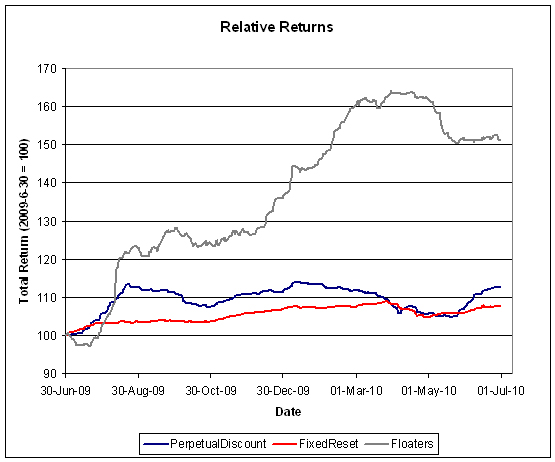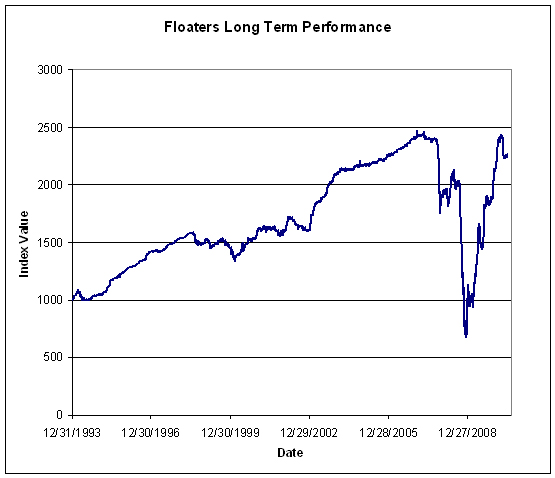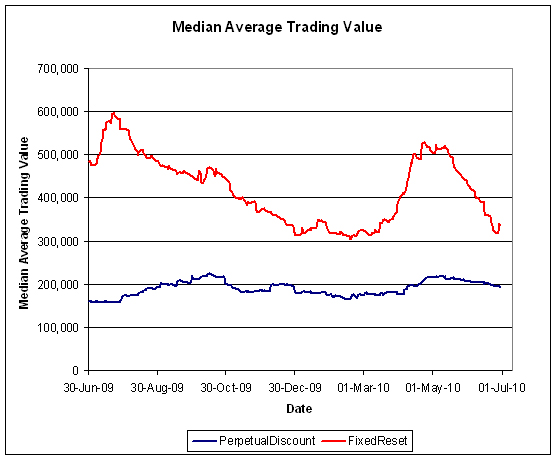There’s some doubt about the EU stress tests:
Investors say they don’t know if some banks are hiding bad loans, whether they have enough capital to withstand a debt default by a European state and whether governments can afford to rescue them. The European Union still hasn’t disclosed the tests’ criteria, including if they contain a sovereign default.
…
Protecting the senior bonds of 11 U.S. banks from default using credit default swaps costs an average of about 144 basis points, according to data compiled by CMA DataVision. In Europe, the average cost has climbed to about 224 basis points this year, the data show.
…
Europe’s largest banks are trading at a discount to their book value while their U.S. counterparts trade at a premium. Europe’s 20 largest lenders are trading at about 10 percent less than the net value of their assets. The 20 biggest U.S. banks trade at a 10 percent premium, Bloomberg data show.
…
Some European lenders used accounting-rule changes made in October 2008, about a month after Lehman Brothers Holdings Inc.’s collapse, to allow them to avoid writedowns on assets based on plunging market values, unless a default was deemed likely. Under pressure from EU leaders, the International Accounting Standards Board approved changes letting financial institutions in more than 100 countries that use International Financial Reporting Standards to reclassify some investments so they no longer had to book paper gains and losses as credit markets fluctuated.Deutsche Bank, for example, used the change to shift about 38 billion euros of assets, including commercial real estate and leveraged finance, into its loan book from the third quarter of 2008 to the first quarter of 2009, saving it a net 3.2 billion euros in markdowns based on valuation gains and losses through the first quarter of 2010. ING Groep NV, the biggest Dutch financial-services company, reclassified 24.4 billion euros and Societe Generale SA shifted 25.3 billion euros in assets, escaping about 2.8 billion euros in losses.
Perhaps in response (yes, OSFI, sometimes regulators respond to investor outcry! How ’bout dat?), C-EBS has released some details:
The macro-economic scenarios include a set of key macro-economic variables (e.g. the evolution of GDP, of unemployment and of the consumer price index), differentiated for EU Member States, the rest of the EEA countries and the US. The exercise also envisages adverse conditions in financial markets and a shock on interest rates to capture an increase in risk premia linked to a deterioration in the EU government bond markets.
On aggregate, the adverse scenario assumes a 3 percentage point deviation of GDP for the EU compared to the European Commission’s forecasts over the two-year time horizon. The sovereign risk shock in the EU represents a deterioration of market conditions as compared to the situation observed in early May 2010.
Mr Joseph S Tracy, Executive Vice President of the Federal Reserve Bank of New York, spoke at the Westchester County Bankers Association, Tarrytown, New York, 25 June 2010, drawing parallels between the Credit Crunch and the Panic of 1907.
There’s an interesting trend in bond underwriting:
Borrowers are obtaining credit from banks competing for a pool of bond deals that dropped to $1.18 trillion in the first half from $1.92 trillion a year earlier as Europe’s sovereign debt crisis pared sales, according to data compiled by Bloomberg. The number of banks on each high-yield deal has almost tripled since 2000, cutting fees by an average of 57 percent per firm.
“We’ve been very clear with our banking business partners that we’ll take care of those who are good to us,” said Martin of London-based Virgin, which enlisted a record 14 banks to sell debt in January. “If you want to be in the bond, we need you to give us your balance sheet as well.”
Martin included Credit Suisse, Citigroup, Barclays Capital and HSBC Holdings Plc in Virgin Media’s bond offering, along with 10 other managers, after they agreed to join a 1.925 billion-pound ($2.9 billion) credit facility. The four banks, whose spokesmen declined to comment, ultimately weren’t needed on the loan.
There’s a big TIPS sale tomorrow and speculation there will be a big concession:
Barclays Plc’s Michael Pond, the top-rated analyst of Treasury Inflation Protected Securities, said the U.S. may struggle to sell a record-tying $12 billon of the securities tomorrow with the government likely to bolster the size of future auctions and inflation expectations low.
“We are concerned that the market will have difficulty absorbing this much supply given other headwinds and believe a significant concession is needed for the auction to go well,” Pond said in a note to clients dated July 2. “The level of real yields combined with the size presents a high hurdle for a good auction.”
…
The $12 billion of 10-year TIPS will match the record amount sold in January 2004. The U.S. will sell $30 billion of the security during the second half of 2010, based on the size of tomorrow’s auction and the Treasury’s plans to reopen the issue twice, Pond wrote. That amount is up from $15 billion worth of sales during the second half of last year and the historical high of $21 billion during the first half of 2004, he wrote.Real yields, which take into account inflation or deflation, have fallen to 1.218 percent on 10-year Treasuries, from 1.685 percent April 2, according to Bloomberg Data. Current real yield levels, only 30 basis points away from the 91 basis point yield experienced in March of 2008 during the deflation scare, leaves the security with “limited upside,” Pond wrote. “At current levels, this would be the lowest yield at a 10-year TIPS auction.
I was briefly quoted in the Globe, deprecating GICs:
So why would anyone choose a government bond?
“The main thing is liquidity,” says James Hymas, president of Hymas Investment Management in Toronto.
With most GICs (cashable GICs being the major exception), you agree to lock in your money for a certain period. In exchange, you earn a higher return. Bonds can be sold at any time, but you earn a lower return.
“I don’t really recommend GICs at the best of times because of the liquidity issue,” he says.
The semi-annual TXPR index rebalancing should be announced soon – last year’s announcement was on Friday, July 10.
PerpetualDiscounts were flat on the day, while FixedResets rose by 15bp on average volume.
PerpetualDiscounts now show a median-weighted-average yield of 5.99%, equivalent to 8.39% interest at the standard equivalency factor of 1.4x. Long corporates now yield about 5.50%, so the pre-tax interest-equivalent spread (also called the Seniority Spread) is now about 290bp, unchanged from June 30.
| HIMIPref™ Preferred Indices These values reflect the December 2008 revision of the HIMIPref™ Indices Values are provisional and are finalized monthly |
|||||||
| Index | Mean Current Yield (at bid) |
Median YTW |
Median Average Trading Value |
Median Mod Dur (YTW) |
Issues | Day’s Perf. | Index Value |
| Ratchet | 2.83 % | 2.93 % | 24,289 | 20.29 | 1 | 0.0000 % | 2,048.5 |
| FixedFloater | 0.00 % | 0.00 % | 0 | 0.00 | 0 | -0.1592 % | 3,093.8 |
| Floater | 2.33 % | 1.97 % | 45,911 | 22.46 | 4 | -0.1592 % | 2,205.1 |
| OpRet | 4.88 % | 2.37 % | 81,254 | 0.08 | 11 | -0.0428 % | 2,339.7 |
| SplitShare | 6.39 % | 6.22 % | 88,649 | 3.45 | 2 | -1.0037 % | 2,169.6 |
| Interest-Bearing | 0.00 % | 0.00 % | 0 | 0.00 | 0 | -0.0428 % | 2,139.4 |
| Perpetual-Premium | 5.97 % | 5.80 % | 118,453 | 1.85 | 4 | 0.1437 % | 1,918.3 |
| Perpetual-Discount | 5.93 % | 5.99 % | 181,718 | 13.94 | 73 | -0.0048 % | 1,823.5 |
| FixedReset | 5.36 % | 3.71 % | 320,116 | 3.49 | 47 | 0.1463 % | 2,202.4 |
| Performance Highlights | |||
| Issue | Index | Change | Notes |
| BNA.PR.C | SplitShare | -2.82 % | YTW SCENARIO Maturity Type : Hard Maturity Maturity Date : 2019-01-10 Maturity Price : 25.00 Evaluated at bid price : 19.27 Bid-YTW : 8.25 % |
| GWO.PR.I | Perpetual-Discount | -1.42 % | YTW SCENARIO Maturity Type : Limit Maturity Maturity Date : 2040-07-07 Maturity Price : 18.70 Evaluated at bid price : 18.70 Bid-YTW : 6.07 % |
| HSB.PR.C | Perpetual-Discount | -1.30 % | YTW SCENARIO Maturity Type : Limit Maturity Maturity Date : 2040-07-07 Maturity Price : 21.21 Evaluated at bid price : 21.21 Bid-YTW : 6.06 % |
| MFC.PR.C | Perpetual-Discount | -1.16 % | YTW SCENARIO Maturity Type : Limit Maturity Maturity Date : 2040-07-07 Maturity Price : 18.73 Evaluated at bid price : 18.73 Bid-YTW : 6.07 % |
| CM.PR.K | FixedReset | -1.13 % | YTW SCENARIO Maturity Type : Call Maturity Date : 2014-08-30 Maturity Price : 25.00 Evaluated at bid price : 26.25 Bid-YTW : 3.92 % |
| PWF.PR.M | FixedReset | 1.17 % | YTW SCENARIO Maturity Type : Call Maturity Date : 2014-03-02 Maturity Price : 25.00 Evaluated at bid price : 26.84 Bid-YTW : 3.70 % |
| PWF.PR.O | Perpetual-Discount | 1.43 % | YTW SCENARIO Maturity Type : Limit Maturity Maturity Date : 2040-07-07 Maturity Price : 23.79 Evaluated at bid price : 23.98 Bid-YTW : 6.05 % |
| PWF.PR.E | Perpetual-Discount | 1.52 % | YTW SCENARIO Maturity Type : Limit Maturity Maturity Date : 2040-07-07 Maturity Price : 22.25 Evaluated at bid price : 22.65 Bid-YTW : 6.07 % |
| Volume Highlights | |||
| Issue | Index | Shares Traded |
Notes |
| BNS.PR.N | Perpetual-Discount | 106,615 | Desjardins crossed 100,000 at 22.75. YTW SCENARIO Maturity Type : Limit Maturity Maturity Date : 2040-07-07 Maturity Price : 22.56 Evaluated at bid price : 22.70 Bid-YTW : 5.79 % |
| TRP.PR.C | FixedReset | 55,375 | Recent new issue. YTW SCENARIO Maturity Type : Limit Maturity Maturity Date : 2040-07-07 Maturity Price : 23.12 Evaluated at bid price : 25.00 Bid-YTW : 3.93 % |
| PWF.PR.P | FixedReset | 51,954 | Recent new issue. YTW SCENARIO Maturity Type : Limit Maturity Maturity Date : 2040-07-07 Maturity Price : 23.20 Evaluated at bid price : 25.25 Bid-YTW : 3.92 % |
| BMO.PR.J | Perpetual-Discount | 45,870 | YTW SCENARIO Maturity Type : Limit Maturity Maturity Date : 2040-07-07 Maturity Price : 19.87 Evaluated at bid price : 19.87 Bid-YTW : 5.75 % |
| BMO.PR.M | FixedReset | 34,840 | YTW SCENARIO Maturity Type : Call Maturity Date : 2013-09-24 Maturity Price : 25.00 Evaluated at bid price : 26.10 Bid-YTW : 3.68 % |
| IAG.PR.C | FixedReset | 33,400 | RBC bought 10,000 from anonymous at 26.80. YTW SCENARIO Maturity Type : Call Maturity Date : 2014-01-30 Maturity Price : 25.00 Evaluated at bid price : 26.77 Bid-YTW : 4.11 % |
| There were 29 other index-included issues trading in excess of 10,000 shares. | |||


